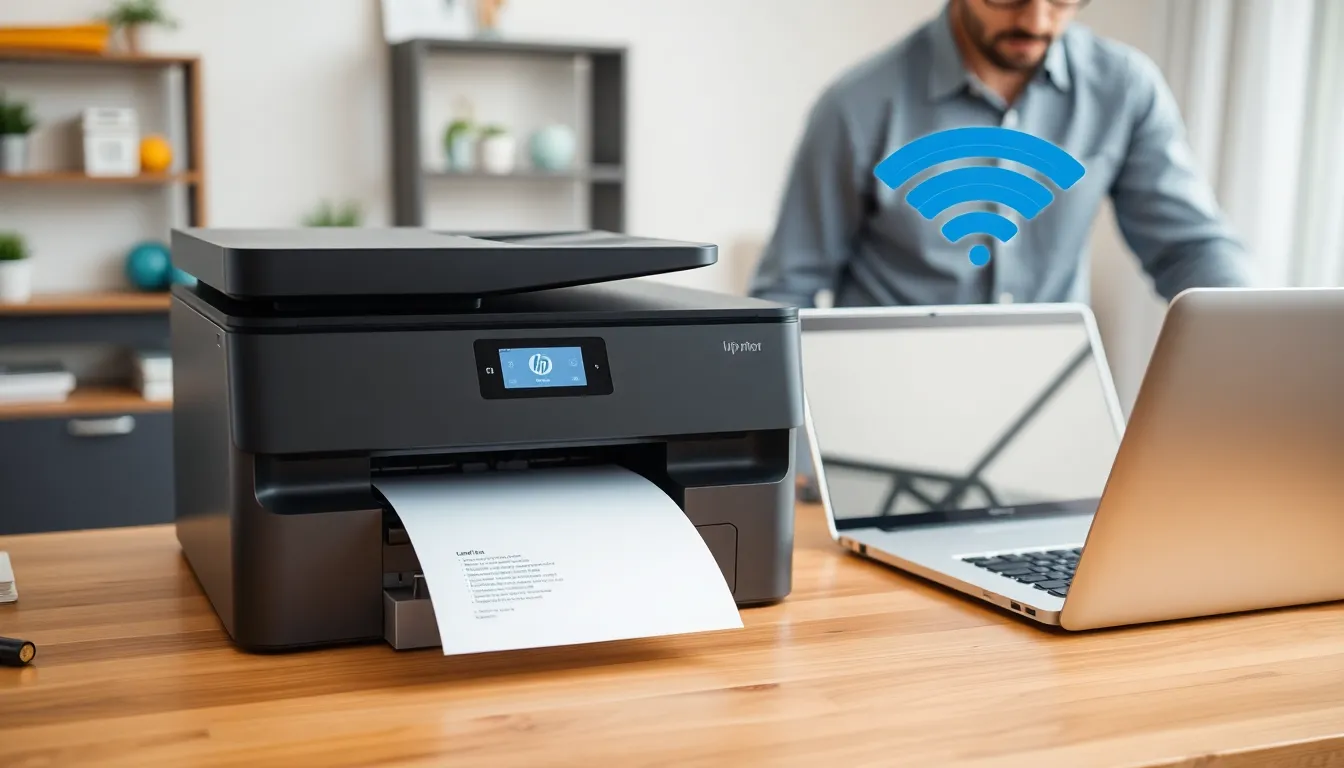Table of Contents
ToggleIn today’s tech-savvy world, getting your HP printer online shouldn’t feel like trying to solve a Rubik’s Cube blindfolded. Whether it’s for printing that last-minute report or your kid’s masterpiece, a reliable connection is key. But why does it seem like printers have their own secret language? Fear not! This guide will turn you into a printer whisperer, making that connection smoother than your morning coffee.
Understanding HP Printers
HP printers offer various features and functionalities suitable for different printing needs. Recognizing these characteristics helps users select the right model for their requirements.
Types of HP Printers
HP provides several types of printers, including inkjet, laser, and all-in-one devices. Inkjet printers excel in delivering high-quality color prints, making them ideal for photos and detailed documents. Laser printers focus on speed and efficiency, producing sharp text quickly. All-in-one printers combine printing, scanning, copying, and faxing capabilities in one machine, catering to versatile user needs. Each type serves distinct purposes, so understanding their features simplifies the selection process.
Common Connectivity Issues
Common connectivity issues can impede seamless printing with HP printers. Users frequently experience problems with Wi-Fi connections, which may result from incorrect network settings. Outdated drivers often cause complications, preventing smooth communication between the printer and device. Additionally, improper installation of the printer can lead to connectivity setbacks. Recognizing these issues early ensures users can troubleshoot and restore connectivity quickly.
Preparing Your HP Printer

Preparing an HP printer for online connectivity involves several simple steps. Users must ensure proper setup to achieve seamless printing.
Checking Printer Compatibility
Verify the printer model to determine its compatibility with the device. Most HP printers function well with Windows and Mac operating systems. Some models also support mobile printing via an app or direct network connections. Consult the HP website or the printer manual for specific compatibility details. Ensuring the printer aligns with the requirements helps prevent connection issues.
Gathering Necessary Information
Collect essential details before proceeding with online setup. Users should note the network name and password for Wi-Fi connections. It’s also important to check for the printer’s IP address, which plays a vital role in linking devices. Finding the specific model number aids in accessing relevant drivers and software on the HP support page. In addition, identifying any existing connection settings streamlines the configuration process.
Connecting HP Printer to Wi-Fi
Establishing a Wi-Fi connection for an HP printer enables convenient, wireless printing. Users can choose between using the HP Smart app or performing a manual wireless setup for this process.
Using the HP Smart App
Downloading the HP Smart app simplifies Wi-Fi connections. This app is available for both iOS and Android devices. After installation, launch the app and sign in with an HP account. The app automatically detects the printer on the same network, making connection effortless. Follow the on-screen prompts to connect the printer to Wi-Fi. Ensure the printer is powered on and within range of the router for optimal results.
Manual Wireless Setup
Manual wireless setup offers direct control over the connection process. First, locate the printer’s control panel and access the wireless setup wizard. Users select their Wi-Fi network from the list provided. After choosing the network, input the Wi-Fi password accurately. Once connected, the printer confirms the connection on its display. Verifying functionality through a test print confirms successful configuration.
Installing Printer Drivers
Installing printer drivers is essential for ensuring HP printers work smoothly with computers and mobile devices. This process can simplify connectivity and enhance printing performance.
Downloading Drivers from HP Website
Accessing the HP website provides users with the latest drivers tailored for specific HP printer models. Search for the printer model in the support section to locate the appropriate drivers. Once found, select the correct operating system to ensure compatibility. Download the driver file, which usually comes in a ZIP format. After downloading, open the file and follow the provided instructions to complete the installation. A successful installation typically prompts the printer to connect automatically, allowing for easy printing.
Installing via CD or USB
Using an installation CD or USB makes driver installation straightforward. Insert the CD into the computer’s drive or connect the USB containing the driver files. Follow the on-screen instructions that guide the user through the installation process. It’s important to connect the printer via USB during this setup to ensure a proper link. Once the installation completes, remove the USB or CD and restart the computer. The printer should now be ready for online operation, facilitating a seamless printing experience.
Final Steps to Get Your HP Printer Online
A few essential steps ensure your HP printer functions smoothly online. Completing these tasks enhances connectivity and confirms the printer’s readiness for use.
Setting the Printer as Default
Setting the printer as default guarantees that it receives print jobs automatically. Identify your HP printer in the list of devices on your computer. Access the Control Panel, then navigate to “Devices and Printers.” Right-click the HP printer icon and select “Set as Default Printer.” A checkmark will appear, indicating the printer is primary. This step prevents confusion during printing and streamlines the process when using multiple printers.
Printing a Test Page
Printing a test page confirms that everything is functioning correctly. Locate the HP printer icon in the “Devices and Printers” section. Right-click on it and select “Printer Properties.” In the new window, find the “Print Test Page” option. Click on it, and the printer will produce a sample document. Successful test prints indicate that the printer is connected properly and prepared for your printing tasks.
Troubleshooting Connection Issues
Connection problems can arise when trying to get an HP printer online. Addressing these issues promptly enhances the printing experience.
Resetting the Network Settings
Resetting the network settings can restore the printer’s connection capabilities. Access the printer’s control panel and navigate to the network settings menu. Choose the option to restore factory settings. This process clears any incorrect configurations that might impede connectivity. After resetting, reconnect the printer to the Wi-Fi network by inputting the network name and password. A successful reconnection usually resolves lingering issues, enabling the printer to communicate effectively with devices.
Checking Firewall and Security Settings
Firewall and security settings sometimes block printer connectivity. Confirm that the printer and connected devices fall within the allowed list on the firewall. Temporarily disabling the firewall can help determine if it’s causing the issue. If the printer connects successfully when the firewall is off, adjust the settings to permit printer access. Additionally, inspecting antivirus software for potential blocking options is crucial. Configuring these settings properly increases the likelihood of seamless communication between the devices.
Getting an HP printer online doesn’t have to be a daunting task. By following the outlined steps and tips, users can easily connect their printers and ensure a smooth printing experience. Proper setup and installation of drivers are crucial for optimal performance.
It’s essential to troubleshoot any connectivity issues as they arise to maintain a reliable connection. With the right approach and a bit of patience, anyone can navigate the complexities of printer connectivity.
Once everything’s set up and tested, users can enjoy hassle-free printing for all their needs.




